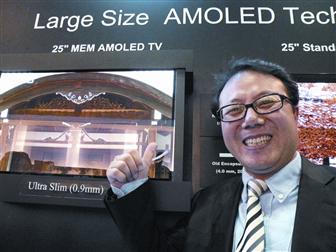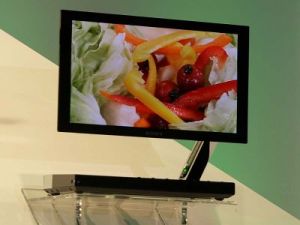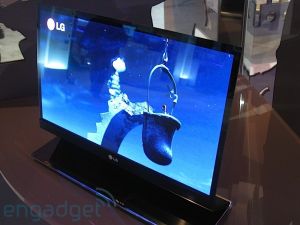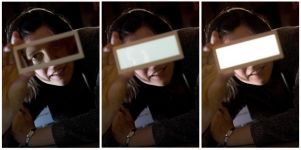We have recently asked Universal Display to give us an update, and answer a few questions... happily Janice Mahon (VP of technology commercialization) has agreed.
 UDC is one of the leading OLED research (IP) companies. They are working on phosphorescent based OLEDs, and have agreement with many companies including Sony, LG Display, Samsung, CMEL, Konica Minolta and DuPont . In face they have recently stated that their technology and materials are used by 'virtually all' AMOLEDs in the market today. We have interviewed Janice back in 2006, and it's great to hear from them again.
UDC is one of the leading OLED research (IP) companies. They are working on phosphorescent based OLEDs, and have agreement with many companies including Sony, LG Display, Samsung, CMEL, Konica Minolta and DuPont . In face they have recently stated that their technology and materials are used by 'virtually all' AMOLEDs in the market today. We have interviewed Janice back in 2006, and it's great to hear from them again.
So here's what Janice has to say:
We’re delighted to have this chance to update you on our progress at Universal Display. Thank you for this opportunity. 2008 was a very exciting year for Universal Display and the OLED industry. A variety of new OLED products hit the market and many more are planned. And as 2009 began, prototype OLED TV’s from three leading manufacturers, LG, Samsung and Sony, were showcased at the Consumer Electronics Show in Las Vegas.
Our phosphorescent OLED technology and materials are proving to be a very important element in achieving desired OLED product performance. Ever since our partners at Princeton University and the University of Southern California demonstrated the first phosphorescent OLED more than a decade ago, it has been widely recognized that they achieved a major breakthrough for the industry. The past few months have certainly provided much evidence of this. Phosphorescence is making OLED displays more power efficient than LCD’s. And, PHOLEDs have enabled the development of efficient white lighting that should compete with incandescent and fluorescent lighting in the foreseeable future.
A few weeks ago you announced that you renewed the 1 year license with CMEL... with another 1 year agreement... The LG agreement was also short. Why are these agreements so short?
We recognize that our industry is young and still rapidly developing. In general, we try to tailor each agreement to meet the specific needs of each customer. Short term agreements allow our customers and Universal Display to maintain flexibility while the industry matures and the marketplace develops. We typically renew our short-term agreements, and as the industry matures we expect that these agreements will become longer term to meet both our customers’ and our needs.
 25 OLED prototype by CMEL
25 OLED prototype by CMELIn your recent Quarterly Conference Call, Sid said "substantially all of the AMOLEDs that are in the market use our technology". We know you have deals with CMEL, LG and Samsung. What about Sony? Is the XEL-1 AMOLED TV using your technology too?
Yes, I understand that Sid’s comment did get some attention. It is very exciting to see that our phosphorescent OLED technology and materials are being used broadly. We have an announced license agreement with Samsung SMD and they were the largest supplier of AMOLED’s during 2008. Sid is a lawyer and doesn’t like to make broad statements without caveats (those lawyers!!). With respect to Sony, we have been working under a technology development relationship for many years.
 Sony XEL1
Sony XEL1Your flexible 4" display at CES was great. you mentioned something about a touch-screen flexible OLEDs... have you started to work on that?
Yes, the 4 wrist-worn display built on flexible metallic foil received a great deal of interest at CES. I have mentioned in the past that touch capability is an important additional feature for a product concept like this. For the time being, though, our focus is on enhancing the intrinsic performance of the flexible AMOLED rather than adding components to the product itself. Touch technology has already been demonstrated in a glass-based AMOLED developed by Samsung SMD and can be found in the iRiver Spinn portable music player. Integrating touch capability with a flexible OLED may create some interesting challenges. Rather than develop it ourselves, our approach would likely be to combine our flexible OLED expertise with that from a touch technology partner.
Still on the 4" flexible...When can we expect a device such as this on the market?
We think that product concepts like this have excellent commercial and military potential, and that the flexible OLED display technology will be ready for use in products like this within the next few years. Whether and when manufacturers like LG Display, Sony and Samsung SMD bring products to market is a question that only they can answer. I can remember that it wasn’t that long ago that folks scoffed at the possibility of a flexible display. Now, with the variety of prototypes and product concepts that are available, it is only just a matter of time.
Can you comment on the recent LG OLED investment? Are they getting ready to mass produce medium sized OLEDs?
Last year, LG announced plans to open a Gen 3.5 OLED fab in the second half of 2009. To then see LG’s 15 OLED TV demos at CES was very exciting. Combined with those from Samsung SMD and Sony, one really gets the sense that OLEDs are going to become a mainstream TV technology before long.
 LG 15-inch OLED at CES 2009
LG 15-inch OLED at CES 2009Your Red materials are used by Samsung... what about your Green ones? Are these being incorporated into their new displays as well?
Yes, our red PHOLED materials are used in a variety of AMOLED products today. We have been working hard to qualify our green PHOLEDs for commercial use as well. During the past year, our team has made significant advances in green PHOLED performance and we believe that our green PHOLEDs now meet the commercial targets for a number of our customers. We have stated that our green PHOLEDs are being evaluated by customers today. Our goal is for customers to start adopting these materials in 2009.
Any updates on the blue PHOLED?
We have a very significant effort here at Universal Display to unlock the secrets to blue PHOLEDs. Our team has demonstrated progress in each of the three key performance parameters: luminous efficiency, color and lifetime. What’s interesting is that with the momentum building around white OLEDs, our blue program has expanded our blue portfolio: deep blues for displays and lighter blues for white lighting.
A while back you announced a 102 L/w white OLED. Any updates? Also, we heard from many companies that this figure is not 'real' but rather a 'lab' result... Can you comment?
Yes, we announced the 102 lumens per watt last summer at our annual shareholders meeting. All results reported by technology developers are, by definition, lab results. But they are certainly very ‘real’ too. I’m curious to know who has suggested otherwise as it is generally well understood that achieving research milestones is a critical step toward reaching similar performance at the commercial scale.
 UDC white light OLED
UDC white light OLEDWhite OLEDs is a core technology platform at Universal Display. We are working on numerous aspects of the technology. These range from demonstrating performance gains at the lab-scale, to developing technologies that allow us to scale those results to larger sizes, and to working with companies like Armstrong World Industries to build commercial lighting product concepts.
There seems to be a lot of effort going into OLED lighting - from GE, Osram, Philips, EU projects, Lumiotec, and more. How will UDC fit into this puzzle?
Yes, it is very exciting to see all of the activity ongoing in white OLED lighting. In a phrase, PHOLEDs = power efficiency. For lighting, our PHOLED technology is a key element for achieving the requisite power efficacy to compete with existing lighting products and for reaching the U.S. DOE’s target of 150 lumens per watt. To answer your specific question, we expect that Universal Display will apply its business model to the lighting industry. Given the opportunities that a new industry engenders, however, our entrepreneurial spirit also inspires us to keenly look beyond our current business model for new opportunities as well.
 Transparent OLEDs by Philips
Transparent OLEDs by PhilipsAny word for your shareholders? It's been a hell of a rollercoaster ride lately...
Yes, it is quite a rollercoaster ride, but we are buckled into our seats tight. We have had no control over the market and economic forces during the past year. Nonetheless, we have managed the company prudently from all business perspectives to maintain and build long-term value for our shareholders. Given today’s environment, our cash management policies have turned out to be especially prudent. As a result, we are able to expand and accelerate our technology during this economic downturn so that we will be in a great position to capitalize when the recovery begins - with state-of-the-art technology and materials to support the growth of the OLED industry.
It seems like OLEDs are finally starting to take off - with many new mobile devices with AMOLEDs (from Samsung mainly, but also LG, Sony, Nokia and others), and larger display planned by Samsung, Sony and LG. Will UDC be a real part of this revolution?
We work with many of the major display manufacturers who are active in OLEDs today. We believe our PHOLED technology will become the standard in the industry. With society becoming increasingly energy conscious, power consumption has become a key product differentiator not only in cell phone displays but also in TV’s. With EnergyStar standards and other energy mandates, displays made with our phosphorescent OLED technology and materials have the potential to provide the low power consumption solution. So, yes, we believe that we will be a real part of this revolution.
How will the current downturn effect OLEDs? Will we see a slowdown in investing?
Some companies use an economic downturn as an opportunity to invest in their next-generation products in anticipation of the inevitable up-cycle. Other companies pull in their horns. I expect that we will see both in this current environment.
Thanks Janice! I really wish you and UDC a great success. Disclosure: The interviewer holds shares in UDC.


Great interview. Thanks.